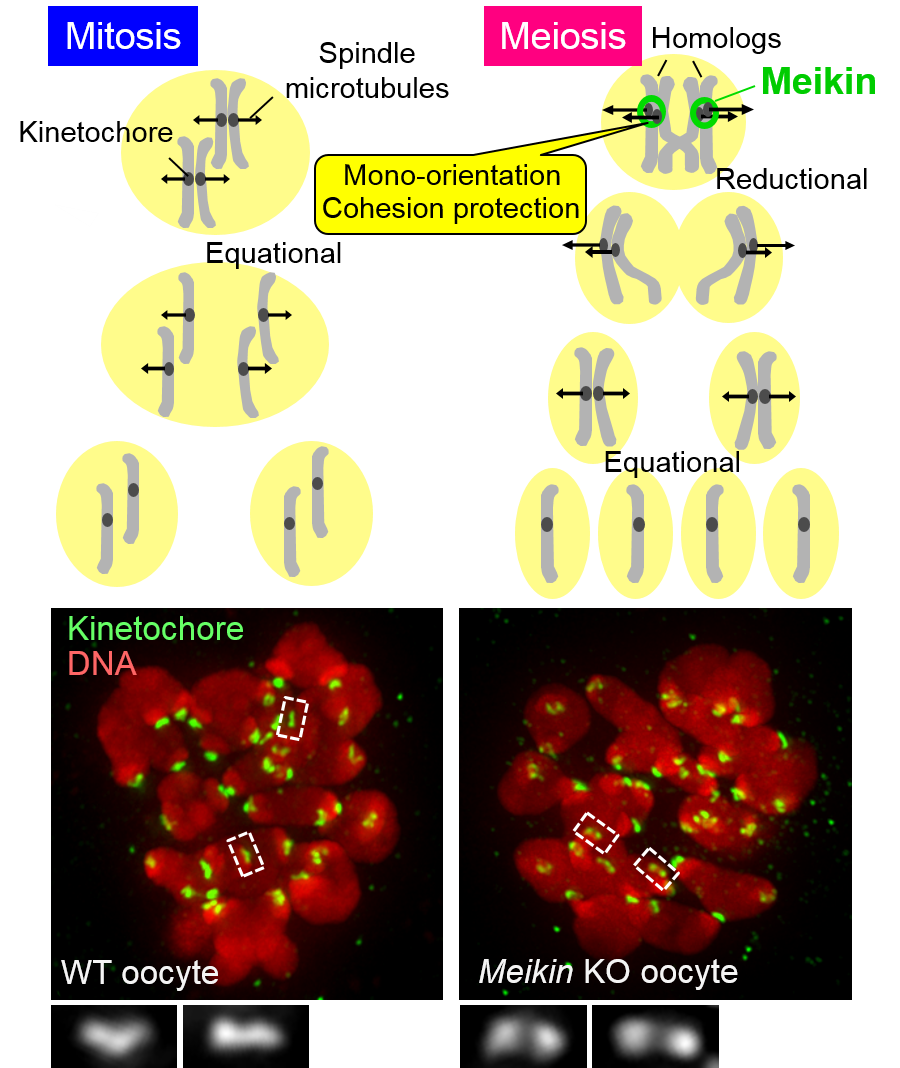Discovery of master regulator of meiosis-specific chromosome segregation Master regulator widely conserved from yeast to humans

There are two types of cell division: mitosis, which is observed in somatic cells such as skin, and meiosis, which occurs in the germ cells that produce sperm and eggs and reduces the chromosomes in half. In mitosis, spindle microtubules emanating from opposite spindle poles attach to the replicated chromosomes (sister chromatids) and segregate equationally (one sister chromatid to each spindle pole; figure upper left). In meiosis, however, homologous chromosomes (one chromosome from each parent) rather than sister chromatids are separated because the kinetochores (to which the microtubules attach) of sister chromatids are captured by microtubules emanating from the same spindle pole, whereas homologous chromosomes, combined by chiasmata at which genetic information is exchanged, are captured from opposite poles (figure, upper right) in an additional reductional division that halves the number of chromosomes. It is known that during this reductional division the kinetochores of the duplicated chromosomes are captured only from one spindle (“mono-orientation”) and remain attached throughout anaphase. Although the existence of a master regulator of meiotic chromosome segregation has been anticipated, its identity has remained elusive.
The research group of Project Researcher Jihye Kim and Professor Yoshinori Watanabe at the University of Tokyo Institute of Molecular and Cellular Biosciences identified a novel kinetochore protein in mouse germ cells, the function of which was completely unknown, and which the group has named Meikin (meiosis-specific kinetochore protein). In knockout mice unable to express the Meikin gene, kinetochore mono-orientation and the protection of cohesion, two characteristics of reductional division, are both defective. Thus, the researchers conclude that Meikin is the long-awaited master regulator of meiotic chromosome segregation. In addition, the researchers showed from an analysis of mice and yeast that the mechanism of chromosome separation in germ cells is conserved in many living organisms including humans.
Elderly human eggs contain an abnormal number of chromosomes found in high frequency, and this is known to be a major cause of birth defects such as Down syndrome. The current findings are expected to contribute significantly to elucidating the cause of infertility or Down syndrome in humans.
Press release (Japanese)
Paper
, "Meikin is a conserved regulator of meiosis-I-specific kinetochore function", Nature Online Edition: 2014/12/25 (Japan time), doi: 10.1038/nature14097.
Article link (Publication)
Links
Institute of Molecular and Cellular Biosciences
Watanabe Laboratory, Chromosome Dynamics, Institute of Molecular and Cellular Biosciences







